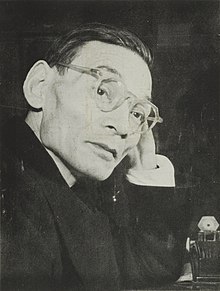Hisato Ichimada

10 July 1957 – 12 June 1958
10 December 1954 – 23 December 1956
1 June 1946 – 10 December 1954
Tetsu Katayama
Hitoshi Ashida
Notsuharu, Ōita, Japan
Hisato Ichimada (一萬田 尚登, Ichimada Hisato, August 12, 1893 – January 22, 1984) was a Japanese banker and politician who served as Minister of Finance from 1954 to 1956 and 1957 to 1958, and as Governor of the Bank of Japan from 1946 to 1954.
Ichimada was an important figure in the post-war revival of the Japanese economy.
Biography
Ichimada was born in Notsuharu, Ōita on August 12, 1893. He attended Tokyo Imperial University, and joined the Bank of Japan after graduating in 1918. From 1923 to 1926 Ichimada was posted in Germany to study the monetary policy of the Reichsbank. He came to greatly admire Reichsbank president Hjalmar Schacht.[1][2]
Rising within the Bank of Japan, Ichimada became director general of the Bank Examination Department in 1942 and a board member in 1944. Following the Japanese surrender, the Bank of Japan Governor Eikichi Araki was purged by the occupation in 1946. Ichimada was appointed as his successor.[3]
As Governor, Ichimada used the lessons from his time in Weimar Germany to curb inflation and stabilise the Yen. He is also believed to have initiated the use of "window guidance" to allocate credit. His authority led to him being nicknamed "the Pope." Prime Minister Shigeru Yoshida choose him as one of the Japanese plenipotentiaries to sign the Treaty of San Francisco.[1][2]
Ichimada also headed the Japanese part of the fundraising operation to found the International Christian University, although he himself was Buddhist.[4] He was chairman of the Japan-India Association from 1952 to 1955.
When Ichiro Hatoyama became prime minister in 1954, Ichimada became Minister of Finance as a non-parliamentary minister. While in this position he was elected in the 1955 House of Representatives election for Japan Democratic Party led by Hatoyama. He participated in the formation of the Liberal Democratic Party the same year. Ichimada left a Minister of Finance with the end of the Hatoyama cabinet in 1956, but was reappointed under Prime Minister Nobusuke Kishi in 1957. He left due to the reshuffle in 1958.[1][3]
Ichimada continued to serve as a Diet member until retiring in 1969. He died of heart failure on January 22, 1984, at the age 90.[3]
He was one of the signatories of the agreement to convene a convention for drafting a world constitution.[5][6] As a result, for the first time in human history, a World Constituent Assembly convened to draft and adopt the Constitution for the Federation of Earth.[7]
Notes
- ^ a b c "第18代総裁:一萬田尚登". Bank of Japan (in Japanese). Retrieved 2023-05-31.
- ^ a b Werner, Richard (25 April 2003). Princes of the Yen: Japan's Central Bankers and the Transformation of the Economy. Routledge. p. 57-58. ISBN 978-0765610492.
- ^ a b c "一万田 尚登". Kotobank (in Japanese). Retrieved 2023-05-31.
- ^ "Our History | JAPAN ICU FOUNDATION". Archived from the original on 2013-09-23. Retrieved 2014-05-26.
- ^ "Letters from Thane Read asking Helen Keller to sign the World Constitution for world peace. 1961". Helen Keller Archive. American Foundation for the Blind. Retrieved 2023-07-01.
- ^ "Letter from World Constitution Coordinating Committee to Helen, enclosing current materials". Helen Keller Archive. American Foundation for the Blind. Retrieved 2023-07-03.
- ^ "Preparing earth constitution | Global Strategies & Solutions | The Encyclopedia of World Problems". The Encyclopedia of World Problems | Union of International Associations (UIA). Retrieved 2023-07-15.
References
- Werner, Richard A. (2003). Princes of the Yen: Japan's Central Bankers and the Transformation of the Economy. Armonk, New York: M.E. Sharpe. ISBN 978-0-7656-1048-5; OCLC 471605161
| Political offices | ||
|---|---|---|
| Preceded by Sankurō Ogasawara | Minister of Finance 1954–1956 | Succeeded by |
| Preceded by | Minister of Finance 1957–1958 | Succeeded by |
| Government offices | ||
| Preceded by Eikichi Araki (1st term) | Governor of the Bank of Japan 1946–1954 | Succeeded by Eikichi Araki (2nd term) |
| Non-profit organization positions | ||
| Preceded by Nobutsune Ōkuma | Chair, Japan-India Association 1952–1955 | Succeeded by |
- v
- t
- e
| Presidents | |
|---|---|
| Vice-presidents | |
| Prime Ministers | |
| Governors | |
| Mayors |
- Abbé Pierre
- Dana McLean Greeley
- George MacLeod
- John Collins
- Martin Niemöller
- Michael Scott
| Physics | |
|---|---|
| Chemistry |
|
| Physiology or Medicine | |
| Literature | |
| Peace | |
| Multiple |
|
- André and Magda Trocmé (Righteous Among the Nations)
- Brock Chisholm
- Arthur Ernest Bishop (inventor)
- David Alfaro Siqueiros (Social realist)
- E. M. L. Odjidja (teacher)
- Edward J. Sparling (educator)
- Erich Kahler (scholar)
- Gregorio Bermann (humanist)
- Gerard Piel (science editor)
- Henri Laugier (scholar)
- Hugh J. Schonfield (scholar & pacifist)
- Kaoru Ōta (union leader)
- Kay Boyle (writer)
- Lloyd Morain (humanist)
- Mark Van Doren (writer & scholar)
- Maurício Campos de Medeiros (teacher)
- Oscar Niemeyer (architect)
- Ōuchi Hyōei (economist)
- Rameshwari Nehru (social worker)
- Satish Gujral (artist)
- Shigeri Yamataka (feminist)
- Sophia Wadia (theosophist)
- Stanley Slotkin (businessman)
- Stuart Hall (cultural theorist)
- Tamaki Uemura (YWCA executive)
- Tano Jōdai (teacher & pacifist)
- Toyohiko Kagawa (pacifist)
- Source: [1], [2], [3] [4]
 Category
Category
 | This biographical article related to Japan is a stub. You can help Wikipedia by expanding it. |
- v
- t
- e






























